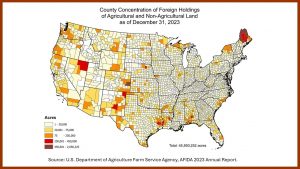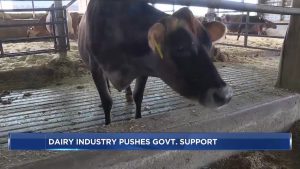
Global markets tumbled as investors began coming to terms with the idea that President Trump’s trade war is here to stay. Benchmark indexes in China, Germany, France and the United States all dropped. American crude oil prices were down roughly 5 percent, amid growing concern that the ongoing trade war would start to drag on global economic demand. The yield on the 10-year Treasury note fell to its lowest level this year, in a sign investors were pricing in lower levels of growth and inflation.
Hopes for a quick resolution to the China trade fight faded further this week, with Treasury Secretary Steven Mnuchin saying on Wednesday that no additional meetings with Beijing are scheduled and that he is encouraging American firms to reorient their supply chains and source their products elsewhere.
China’s president Xi Jinping this week called for the Chinese people to begin a modern “long march,” invoking a time of hardship from the country’s history as it braces for a protracted trade war with the United States.
“I am growing more and more skeptical that there is a place where the two sides can come to a deal,” said Edward Alden, a fellow at the Council on Foreign Relations. “If I look at the positions the two sides have taken at the moment, I do not see a path to a deal.”
More companies have been pulling back from doing business with Chinese firms, especially multinationals that provided services to Huawei, the telecommunications equipment giant. The Trump administration announced last week that it would blacklist Huawei over security concerns, prompting Google and mobile carriers to say they would no longer do business with it.
The Huawei ban, coupled with Mr. Trump’s decision to raise tariffs on $200 billion worth of goods and begin the process to tax another $300 billion have exacerbated tensions with Beijing. It has vowed to further retaliate on American products, particularly agricultural goods.
In a note Wednesday, analysts from Nomura Global Markets Research said their baseline scenario was that Mr. Trump would put a 25 percent tariff on all Chinese exports to the United States by the end of 2019, most likely after he is scheduled to meet with Mr. Xi Jinping at the G-20 in late June.
More restrictions on dealing with Chinese tech companies could come soon. The New York Times reported Tuesday that the Trump administration is considering another ban on American companies supplying components to Hikvision, a Chinese surveillance camera maker that has been criticized for playing a role in the Chinese government’s monitoring and repression of Uighurs, a mostly Muslim ethnic minority.
The Commerce Department said Monday that it would allow Huawei to continue doing business with American companies for 90 days to prevent disruption to mobile networks that use the company’s equipment. But many companies are quickly announcing plans to exit their relationships with Huawei. In addition to Google, which announced that it would cut off support to Huawei for Android hardware and software services, as well as popular applications like Maps and Gmail, German supplier Infeon announced a similar ban. The benchmark index of American semiconductor stocks fell more than 2 percent in early trading, as investors continued to grapple with Trump administration efforts to restrict sales to Huawei.
Mr. Trump has been fighting several trade wars at once, wielding tariffs against metals from Europe, Japan, Canada and Mexico as well as goods from China. In response, trading partners have hit back at American farmers, imposing punishing tariffs on everything from peanut butter to soybeans to orange juice.
Over the last week, the Trump administration has moved to resolve or delay trade conflicts on other fronts, to better focus its efforts on Beijing. While Mr. Trump has insisted any pain will be short-lived and worth the price, administration officials have grown concerned that the president could lose the support of farmers, an important political constituency, ahead of the 2020 election. Those worries helped spur Mr. Trump last week to suddenly drop steel and aluminum tariffs on Canada and Mexico, which agreed in turn to withdraw stiff levies on American farm goods.
On Thursday, the administration took another step to help insulate farmers, with the Agriculture Department saying it would provide up to $16 billion in aid to farmers hurt by Chinese trade retaliation. The amount “is in line with the estimated impacts of unjustified retaliatory tariffs on U.S. agricultural goods and other trade disruptions,” the department said in a statement.
The new program will make $14.5 billion in direct payments to producers, channeled through the Commodity Credit Corporation, a program that helps shore up American farmers by buying their crops. The payments will be made to agricultural producers for a wide range of products, from soybeans and cotton to chickpeas and cherries, in up to three tranches, beginning in late July or early August.
The government will also implement a $1.4 billion program to purchase surplus commodities affected by the trade war and distribute them to food banks, schools and other programs for the poor, as well as put another $100 million toward developing new export markets for American farmers.
The financial support comes after the administration handed out $12 billion in emergency relief for farmers last year, also funded through the Commodity Credit Corporation.
“China hasn’t played by the rules for a long time and President Trump is standing up to them, sending the clear message that the United States will no longer tolerate their unfair trade practices, which include non-tariff trade barriers and the theft of intellectual property,” Sonny Perdue, the agriculture secretary, said in a statement.
Jim Costa, a congressman from California who heads the House agriculture subcommittee, criticized the plan as a “rushed and poorly-planned bailout” that might end up giving less aid to some farmers, like those who grow fruit and vegetable crops in central California.
“For more than a year now, producers of every commodity have said the same thing: they want long-term access to export markets, not hasty attempts by the federal government to clean up its own mess,” Mr. Costa said. “I urge the White House to rescind the tariffs and sit down in a constructive manner with the Chinese to address issues that will actually improve the market for our farmers.”
Other lawmakers were more supportive of the financial support. Senator Kevin Cramer, a Republican from North Dakota, said he was taken completely by surprise when Mr. Trump signaled he would allocate the new farm money earlier this month — and is optimistic the president will steer more money to farmers if enough Republicans call him directly to make the request.
“It’s a good start. If we need more later, we will go through the fight again. We got $16 billion, but maybe we’ll need $20 billion,” Mr. Cramer said on Thursday.
The collateral damage to farmers from the trade clash with China now looms as a potential obstacle to the president’s re-election. China’s tariffs against products like soybeans and beef and a recent move to cancel a major pork order have hit swing states, including Iowa, Ohio and Wisconsin, especially hard.
A survey of 400 American farmers by Purdue University and the CME Group, a global markets company, showed that sentiment plunged in April, stemming from concerns about worsening tensions with China. Only 28 percent of farmers surveyed said that they believed a soybean dispute with China would be resolved by July 1, down from 45 percent in March, while 74 percent of those surveyed said now was a “bad time” to make big farm investments.
“Farmers are becoming increasingly anxious over their future financial performance,” said James Mintert, the survey’s principal investigator and director of Purdue University’s Center for Commercial Agriculture.
The president is increasingly focused on rural communities as he looks ahead to a fight with the Democratic nominee for the 2020 election.
Mr. Trump’s political advisers have pointed to the rapid rise of Joseph R. Biden Jr. to the top of Democrats’ 2020 field, powered, in part, by the former vice president’s popularity with blue-collar voters in Pennsylvania, Michigan and Wisconsin, as a reason to mitigate the pain on farms and factories of tariffs in the Midwest, current and former administration officials said.
That has spurred Mr. Trump to relent on some of his other trade battles, including relaxing metal tariffs on Canada and Mexico and delaying a decision on whether to impose tariffs on foreign cars for another six months.
On Monday, Canada and Mexico officially lifted the tariffs they had imposed on American pork, milk, cheese, wine and other products, a major relief to American farmers who count the countries as two of their top three export markets, in addition to China. And Europe, which had been drawing up more American products to tax in the event of auto levies has, for now, moved away from that plan.
Tom Vilsack, a former agriculture secretary who now represents the dairy industry, said on Friday that the removal of the metal tariffs on Canada and Mexico was an important step but that passage of the revised North American trade agreement and new trade deals with China and Japan remain most crucial to reviving the dairy sector.
“With the difficulties experienced with the China talks, it was fair to assume that the administration needed to have some positive news coming out of the trade side of the shop,” Mr. Vilsack said.























